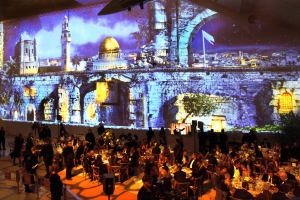- Christie technology and BARTKRESA Design took visitors back in time at the California Science Center Discovery Ball fundraiser, showcasing the Dead Sea Scrolls and their history in a two-story projection mapping display using eight screens and 14 Christie 3DLP projectors.
The night time illustration put on during the Discovery Ball.
Serving an average of two million guests annually with an audience among the most diverse of any museum or science center in North America, the California Science Center, located near the Los Angeles Memorial Coliseum, is a vital community resource and an integral part of California’s educational infrastructure.
“The Discovery Ball was very thematic and we wanted to give people the sense they were in a different place,” said Christina Sion, vice president, Food & Event Services, California Science Center Foundation. “For the Dead Sea Scrolls exhibit we premiered at the gala, it made sense to use projection and there is nobody on the planet I would ask to do this more than Bart Kresa. We have worked together before and I always admire his work. It continues to get bigger, better and more incredible.”
Two Christie Roadie HD+35K 3DLP projectors were used on the largest screen with the other 12 -two Roadster HD20K-J, eight Roadster HD14K-M, and two Roadster HD10K-M - used for the medium and smaller screens.
The evening started with a cocktail party with guests walking into simulated versions of the Qumran Caves where the Dead Sea Scrolls were discovered. Guests then left the caves, making their way down the escalator where they then experienced the projection mapping display in the large dining area.
“It was the entire two-story atrium of the dining space, which made it so extra spectacular. It was enormous. And because it was so big and we needed the right projectors in order to make this really pop because there was a lot of space to cover,” said Sion. “We wanted people to feel like they were there – at the site. And they did.”
A project of this magnitude has its challenges but BARTKRESA Design overcame the issues facing them.
“One challenge was figuring out how to project on a wall with two airplanes hanging in front. To solve the problem we used the wide angle lenses and extreme projection angles, which was corrected with warping the image,” said Bart Kresa. “The other challenge was to project at difficult angles onto a big, 2-story tall screen. To overcome that, we created distorted content that looked correct when it was projected onto the screen. We used Christie projectors because they are very dependable, produce a great quality picture, and provide great color.”
Rather than a static display, the projection was a living entity with guests experiencing a full day in ancient Israel in one evening.
“We projected the Dead Sea so the view of Israel seemed like back in ancient times with the display gradually changed throughout the Discovery Ball,” said Kresa. “We projected a daytime look, then a sunset look and then a night look. We then ended it with a fire-like ceremony that created a whole scene with flames and candles.”
“It was so pretty and subtle that it didn’t distract the guests from the speaker and the other things we were doing,” added Sion. “There were guests who have been to Israel who said the projection display was even more beautiful than the real thing. That is a huge compliment. It was beautiful and breathtaking and made the entire evening. Bart's immersive décor was truly a high point.
